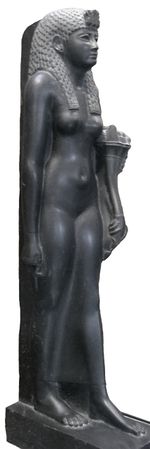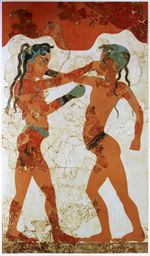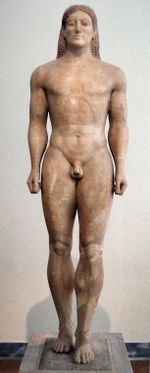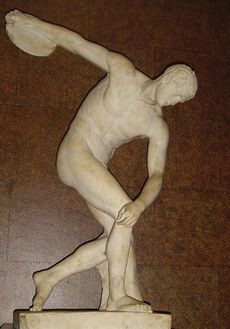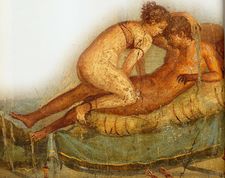تاريخ العري
تاريخ العري يتناول المواقف الاجتماعية من العري في الثقافات المختلفة عبر التاريخ. لا يعرف متى بدأ البشر في ارتداء المبلاس، على الرغم من وجود بعض الأدلة الأثرية التي تشير إلى أن الملابس أصبحت شائعة في المجتمعات البشرية منذ حوالي 72.000 سنة مضت.[1] التعري (أو شبه التعري) كان تقليدياً هو القاعدة الاجتماعية لكل من الرجال والنساء في بعض حضارات الصيد والرعي في المناخات الدافئة ولا يزال شائعاً بين العديد من الشعوب الأصلية. يعتقد علماء الإنسان أن جلود الحيوان وأوراق النباتات كانت تستخدم لحماية الجسم من البرد، الحر والأمطار، وخاصة من قبل البشر الذين هاجروا إلى المناطق المناخية الجديدة؛ أو أن تغطية الجسم قد اخترعت قبل ذلك لأغراض أخرى، مثل السحر، التزيين، العبادة، أو المكانة الاجتماعية، وأصبحت تمارس لاحقاً.[بحاجة لمصدر]
كان المصريون القدماء يرتدون القليل من الملابس، وفي عدد من الحضارات المتوسطية القديمة، كان تعري الرجال والصبية أثناء التريض أو العبادة مفهوماً طبيعياً. في روما القديمة، كان ينظر للتعري في الأماكن العامة كشيئاً مشيناً وكان يعتبر فعلاً مسيئاً أو مقيتاً في الأماكن التقليدية، على الرغم من أنه يمكن رؤيته في الحمامات العامة أو في الفنون الشبقية. في اليابان، كان التعري في الأماكن العامة طبيعياً وشائعاً تماماً حتى استرداد ميجي. في أوروپا، بدأت التابوهات ضد التعري في التزايد في عصر التنوير وأثناء الفترة الڤيكتورية، وكان التعري الجماعي يعتبر فحشاً. في السنوات المبكرة من القرن 20، بدأ مذهب العري في التطور.
التاريخ العتيق
مصر القديمة
اليونان القديمة

روما القديمة
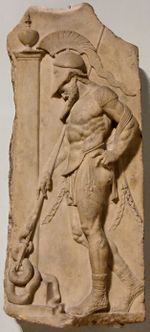
اليابان
الحضارات التقليدية
التاريخ الحديث

الأطفال
انظر أيضاً
- عري مسيحي
- American Gymnosophical Association
- تصوير العري
- History of the Rechabites
- قائمة أماكن العري الاجتماعية
- العري والجنسانية
- العري في القتال
- العري في الرياضة
- عري عام
- خط زمني للعري الاجتماعي الغير جنسي
المصادر
<ref> ذو الاسم "bustle2016" المُعرّف في <references> غير مستخدم في النص السابق.- Golden, Mark (2004). Sport in the Ancient World from A to Z. Routledge. ISBN 1-134-53595-3.
{{cite book}}: Invalid|ref=harv(help) - Vincent, Susan (2013). "From the Cradle to the Grave: Clothing and the early modern body". In Sarah Toulalan & Kate Fisher (ed.). The Routledge History of Sex and the Body: 1500 to the Present. Routledge. ISBN 978-0-415-47237-1.
- Zanker, Paul (1990). The Power of Images in the Age of Augustus. University of Michigan Press. ISBN 0-472-08124-1.
- Crowther, Nigel B. (December 1980 – January 1981). "Nudity and Morality: Athletics in Italy". The Classical Journal. The Classical Association of the Middle West and South. 76 (2): 119–123. JSTOR 3297374.
{{cite journal}}: Invalid|ref=harv(help) - Williams, Craig A. (31 December 2009). Roman Homosexuality (2 ed.). Oxford University Press. ISBN 978-0-19-974201-1.
- Altenmüller, Hartwig (1998). Egypt: the world of the pharaohs. Cologne: Könemann.
- Habinek, Thomas (1997). "The invention of sexuality in the world-city of Rome". In Thomas Habinek & Alessandro Schiesaro (ed.). The Roman Cultural Revolution. Cambridge University Press. ISBN 978-0-521-58092-2.
- Blanshard, Alastair J. L. (2010). Sex: Vice and Love from Antiquity to Modernity. John Wiley & Sons. ISBN 978-1-4443-2357-3.
- Richlin, A. (2002). L. K. McClure (ed.). "Pliny's Brassiere". Sexuality and Gender in the Classical World: Readings and Sources. Oxford: Blackwell Publishers Ltd: 225–256. doi:10.1002/9780470756188.ch8.
- Arney, Kat (29 September 2003). "Head lice key to clothing history". BBC News. Retrieved 2014-08-16.
{{cite web}}: Invalid|ref=harv(help) - Sneed, Joseph D. "Technology, Environment, Adaptation: Early America". Colorado School of Mines. Retrieved 2014-08-16.
- Younger, John (2004). Sex in the Ancient World from A to Z. Routledge. ISBN 978-1-134-54702-9.
- Graf, Fritz (2005). "Satire in a ritual context". In Kirk Freudenburg (ed.). The Cambridge Companion to Roman Satire. Cambridge University Press. ISBN 978-1-139-82657-0.
- Heskel, Julia (2001). "Cicero as Evidence for Attitudes to Dress in the Late Republic". In Judith Lynn Sebesta & Larissa Bonfante (ed.). The World of Roman Costume. University of Wisconsin Press.
- Carter, Michael (2009). "(Un)Dressed to Kill: Viewing the Retiarius". In Jonathan Edmondson & Alison Keith (ed.). Roman Dress and the Fabrics of Roman Culture. University of Toronto Press. ISBN 978-1-4426-9189-6.
- Sharrock, Allison R. (2002). "Looking at Looking: Can You Resist a Reading?". In David Fredrick (ed.). The Roman Gaze: Vision, Power, and the Body. JHU Press. ISBN 978-0-8018-6961-7.
- Clarke, John R. (2002). "Look Who's Laughing at Sex: Men and Women Viewers in the Apodyterium of the Suburban Baths at Pompeii". In David Fredrick (ed.). The Roman Gaze: Vision, Power, and the Body. JHU Press. ISBN 978-0-8018-6961-7.
- Fredrick, David (2002). "Invisible Rome". In David Fredrick (ed.). The Roman Gaze: Vision, Power, and the Body. JHU Press. ISBN 978-0-8018-6961-7.
- Cameron, Alan (2010). The Last Pagans of Rome. Oxford University Press, USA. ISBN 978-0-19-978091-4.
- Cohen, Beth (2003). "Divesting the Female Breast of Clothes in Classical Sculpture". In Ann Olga Koloski-Ostrow & Claire L. Lyons (ed.). Naked Truths: Women, Sexuality and Gender in Classical Art and Archaeology. Routledge. ISBN 978-1-134-60386-2.
- Del Bello, Davide (2007). Forgotten Paths: Etymology and the Allegorical Mindset. CUA Press. ISBN 978-0-8132-1484-9.
- Schäfer, Peter (2003). The History of the Jews in the Greco-Roman World. Psychology Press. ISBN 978-0-415-30585-3.
- Dr. Jacobus X (pseud.) (1937). Untrodden fields of anthropology: by Dr. Jacobus; based on the diaries of his thirty years' practice as a French government army-surgeon and physician in Asia, Oceania, America, Africa, recording his experiences, experiments and discoveries in the sex relations and the racial practices of the arts of love in the sex life of the strange peoples of four continents. Vol. 2. New York: Falstaff Press.
{{cite book}}: Invalid|ref=harv(help) - Siegelbaum, Lewis H. (1992). Soviet State and Society Between Revolutions, 1918-1929. Cambridge University Press. ISBN 978-0-521-36987-9.
- Chughtai, A.S. "Ibn Battuta - The Great Traveller". Archived from the original on 13 مارس 2012.
{{cite web}}: Unknown parameter|deadurl=ignored (|url-status=suggested) (help)
قراءات إضافية
- Gill, Gordon (1995). Recreational Nudity and the Law: Abstracts of Cases. Dr. Leisure. ISBN 978-1-887471-01-5.
- Carr-Gomm, Philip (2012). A Brief History of Nakedness. Reaktion Books. ISBN 978-1-86189-729-9.
{{cite book}}: Invalid|ref=harv(help) - Rouche, Michel, "Private life conquers state and society", in A History of Private Life vol I, Paul Veyne, editor, Harvard University Press 1987 ISBN 0-674-39974-9
- Beidelman, T. O. (2012). "Some Nuer Notions of Nakedness, Nudity, and Sexuality". Africa. 38 (02): 113–131. doi:10.2307/1157242. ISSN 0001-9720.
- Asher-Greve, Julia M.; Sweeney, Deborah (2006). "On nakedness, nudity, and gender in Egyptian and Mesopotamian art". In Silvia Schroer (ed.). Images and Gender: Contributions to the Hermeneutics of Reading Ancient Art. Fribourg: Academic Press. ISBN 978-3-525-53020-7.
- Robinson, Julian (1988). Body packaging: a guide to human sexual display. Elysium Growth Press.
وصلات خارجية
- Nudity in art Today by Art Lister
- 20th century nude in the "History of Art"
- Nudity in Ancient to Modern Cultures by Aileen Goodson (This chapter excerpt is from Aileen Goodson's Therapy, Nudity & Joy)

